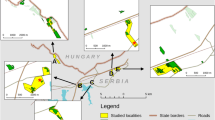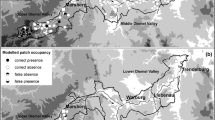Abstract
Based on metapopulation theory, isolation, patch size and habitat quality within patches have recently been identified as the most critical parameters determining the persistence of species. In the special case of flightless and sedentary Orthoptera species, taking into account the low dispersal ability, species survival probably depends more on habitat quality than on isolation. The aim of this study was to document how landscape (patch size, isolation and climate) and microhabitat (vegetation structure, microclimate and land use) factors influence patch occupancy and population densities, respectively, of a flightless bush-cricket (Metrioptera brachyptera) in fragmented calcareous grasslands. In summer 2005 patch occupancy of M. brachyptera was assessed in 68 calcareous grassland patches of the Diemel Valley (central Germany). Among these, 26 patches with 80 plots were selected to characterise M. brachyptera habitats in detail. On each plot, bush-cricket density was sampled in an area of 20 m2 using a 0.5 m2 box quadrat. At the landscape level (patches) in 46 (68%) of 68 studied calcareous grassland patches M. brachyptera was present. Patch occupancy increased with annual precipitation and patch size but was independent of altitude, annual temperature and isolation. At the microhabitat level (plots), population density of M. brachyptera decreased with land-use intensity and increased with vegetation height. In addition, a high litter accumulation was adverse for M. brachyptera. Given the low explanatory power of isolation for patch occupancy, conservation of flightless and sedentary insects, such as M. brachyptera, should primarily focus on improving habitat quality. For M. brachyptera and other stenotopic calcareous grassland species we therefore recommend traditional rough grazing with sheep, which creates a heterogenous habitat structure and avoids the accumulation of too much litter.





Similar content being viewed by others
References
Anthes N, Fartmann T, Hermann G, Kaule G (2003) Combining larval habitat quality and metapopulation structure—the key for successful management of pre-alpine Euphydryas aurinia colonies. J Insect Conserv 7:175–185. doi:10.1023/A:1027330422958
Anthes N, Fartmann T, Hermann G (2008) The Duke of Burgundy butterfly and its dukedom: larval niche variation in Hamearis lucina across Central Europe 12:3–14. doi: 10.1007/s10841-007-9084-7
Appelt M, Poethke H-J (1997) Metapopulation dynamics in a regional population of the blue-winged grasshopper (Oedipoda caerulescens; Linnaeus 1758). J Insect Conserv 1:205–214. doi:10.1023/A:1018468017604
Berggren Å, Carlson A, Kindvall O (2001) The effect of landscape composition on colonization success, growth rate and dispersal in introduced bush-crickets Metrioptera roeseli. J Anim Ecol 70:663–670. doi:10.1046/j.1365-2656.2001.00525.x
Berggren Å, Birath B, Kindvall O (2002) Effect of corridors and habitat edges on dispersal behavior, movement rates, and movement angles in Roesel’s bush-cricket (Metrioptera roeseli). Conserv Biol 16:1562–1569. doi:10.1046/j.1523-1739.2002.01203.x
Bömer A (1893) Die Moore Westfalens. Der Kreis Ahaus (Band 1). Buchdruckerei „Die Post”, Berlin
Bruckhaus A (1994) Das Springschreckenvorkommen von bewirtschafteten und unbewirtschafteten Kalkmagerrasen der Nordeifel. Articulata 9:1–14
Carlsson A, Kindvall O (2001) Spatial dynamics in a metapopulation network: recovery of a rare grasshopper Stauroderus scalaris from population refuges. Ecography 24:452–460. doi:10.1111/j.1600-0587.2001.tb00480.x
Casula P (2006) Evaluating hypotheses about dispersal in a vulnerable butterfly. Ecol Res 21:263–270. doi:10.1007/s11284-005-0130-1
Diekötter T, Csencsics D, Rothenbühler C, Billeter R, Edwards PJ (2005) Movement and dispersal patterns in the bush cricket Pholidoptera griseoaptera: the role of developmental stage and sex. Ecol Entomol 30:419–427. doi:10.1111/j.0307-6946.2005.00714.x
Diekötter T, Speelmans M, Dusoulier F, van Wingerden WKRE, Malfait JP, Crist TO, Edwards PJ, Dietz H (2007) Effects of landscape structure on movement patterns of the flightless bush cricket Pholidoptera griseoaptera. Environ Entomol 36:90–98
Eichel S, Fartmann T (2008) Management of calcareous grasslands for Nickerl’s fritillary (Melitaea aurelia) has to consider habitat requirements of the immature stages, isolation, and patch area. J Insect Conserv 12:677–688. doi:10.1007/s10841-007-9110-9
Fahrig L (2003) Effects of habitat fragmentation on biodiversity. Annu Rev Ecol Evol Syst 34:487–515
Fartmann T (2004) Die Schmetterlingsgemeinschaften der Halbtrockenrasen-Komplexe des Diemeltales. Biozönologie von Tagfaltern und Widderchen in einer alten Hudelandschaft. Abh Westf Mus Naturkunde 66:1–256
Fartmann T (2006) Oviposition preferences, adjacency of old woodland and isolation explain the distribution of the Duke of Burgundy butterfly (Hamearis lucina) in calcareous grasslands in central Germany. Ann Zool Fenn 43:335–347
Fartmann T, Mattes H (1997) Heuschreckenfauna und Grünland—Bewirtschaftungsmaßnahmen und Biotopmanagement. Arb Inst Landschaftsökol 3:179–188
Fartmann T, Behrens M, Loritz H (2008) Orthopteran communities in the conifer-broadleaved woodland zone of the Russian Far East. Eur J Entomol 105:673–680
Frankham R, Ballou JD, Briscoe DA (2009) Introduction to conservation genetics, 2nd edn. Cambridge University Press, Cambridge
Gardiner T, Dover J (2008) Is microclimate important for Orthoptera in open landscapes? J Insect Conserv 12:705–709. doi:10.1007/s10841-007-9104-7
Gardiner T, Hill J (2006) A comparison of three sampling techniques used to estimate population density and assemblage diversity of Orthoptera. J Orthoptera Res 15:45–51
Gardiner T, Hill J, Chesmore D (2005) Review of the methods frequently used to estimate the abundance of Orthoptera in grassland ecosystems. J Insect Conserv 9:151–173. doi:10.1007/s10841-005-2854-1
Hanski I (1999) Metapopulation ecology. Oxford University Press, Oxford
Hanski I, Ovaskainen O (2000) The metapopulation capacity of a fragmented landscape. Nature 404:755–758. doi:10.1038/35008063
Harrison S, Bruna E (1999) Habitat fragmentation and large-scale conservation: what do we know for sure? Ecography 22:225–232. doi:10.1111/j.1600-0587.1999.tb00496.x
Hein S, Gombert J, Hovestadt T, Poethke H-J (2003) Movement patterns of the bush cricket Platycleis albopunctata in different types of habitat: matrix is not always matrix. Ecol Entomol 28:432–438. doi:10.1046/j.1365-2311.2003.00531.x
Hermann G (1999) Methoden zur qualitativen Erfassung von Tagfaltern. In: Settele J, Feldmann R, Reinhardt R (eds) Die Tagfalter Deutschlands. Ulmer, Stuttgart, pp 124–143
Hjermann DO, Ims RA (1996) Landscape ecology of the wart-biter Decticus verrucivorus in a patchy landscape. J Anim Ecol 65:768–780
Ingrisch S (1979) Experimentell-ökologische Freilanduntersuchungen zur Monotopbindung der Laubheuschrecken (Orthoptera: Tettigoniidae) im Vogelsberg. Beitr Naturkunde Osthessen 15:33–95
Ingrisch S, Köhler G (1998) Die Heuschrecken Mitteleuropas. Westarp Wissenschaften, Magdeburg
Kindvall O (1996) Habitat heterogeneity and survival in a bush cricket metapopulation. Ecology 77:207–214
Kindvall O (1999) Dispersal in a metapopulation of the bush cricket, Metrioptera bicolor (Orthoptera: Tettigoniidae). J Anim Ecol 68:172–185. doi:10.1046/j.1365-2656.1999.00273.x
Kindvall O, Ahlén I (1992) Geometrical factors and metapopulation dynamics of the bush cricket, Metrioptera bicolor Philippi (Orthoptera: Tettigoniidae). Conserv Biol 6:520–529. doi:10.1046/j.1523-1739.1992.06040520.x
Kleinert H (1992) Entwicklung eines Biotopbewertungskonzeptes am Beispiel der Saltatoria (Orthoptera). Articulata Beiheft 1:1–117
Kleukers RMJC, van Nieukerken EJ, Odé B, Willemse LPM, van Wingerden WKRE (2004) De sprinkhanen en krekels van Nederland (Orthoptera), 2nd edn. Nederlandse Fauna 1. Nationaal Natuurhistorisch Museum, KNNV Uitgeverij & EIS-Nederland, Leiden
Köhler G (1996) The ecological background of population vulnerability in Central European grasshoppers and bush-crickets: a brief review. In: Settle J, Margules CR, Poschold P, Henle K (eds) Species survival in fragmented landscapes. Kluwer, Dordrecht, pp 290–298
Kruess A, Tscharntke T (2002) Grazing intensity and the diversity of grasshoppers, butterflies, and trap-nesting bees and wasps. Conserv Biol 16:1570–1580
Maes D, Ghesquiere A, Logie M, Bonte D (2006) Habitat use and mobility of two threatened coastal dune insects: implications for conservation. J Insect Conserv 10:105–115. doi:10.1007/s10841-006-6287-2
Marini L, Fontana P, Battisti A, Gaston KJ (2009) Response of orthopteran diversity to abandonment of semi-natural meadows. Agric Ecosyst Environ 132:232–236. doi:10.1016/j.agee.2009.04.003
Marshall JA, Haes ECM (1988) Grasshoppers and allied insects of Great Britain and Ireland. Harley, Colchester
Müller-Temme E (1986) Niederschläge in raum-zeitlicher Verteilung. Geographisch-landeskundlicher Atlas II, Lieferung 6. Geographische Kommission für Westfalen, Münster
Müller-Wille W (1981) Westfalen. Landschaftliche Ordnung und Bindung eines Landes, 2nd edn. Aschendorffsche Verlagsbuchhandlung, Münster
MURL NRW (Minister für Umwelt, Raumordnung und Landwirtschaft des Landes Nordrhein-Westfalen) (ed) (1989) Klima-Atlas von Nordrhein-Westfalen. Selbstverlag, Düsseldorf
Polus E, Vandewoestijne S, Choutt J, Baguette M (2007) Tracking the effects of one century of habitat loss and fragmentation on calcareous grassland butterfly communities. Biodivers Conserv 16:3423–3436. doi:10.1007/s10531-006-9008-y
Poniatowski D, Fartmann T (2007) Kleinräumig heterogen strukturierte Hochheiden in mikroklimatisch günstiger Lage—Lebensräume der Kurzflügeligen Beißschrecke (Metrioptera brachyptera) im Quellgebiet der Diemel (Südwestfalen/Nordhessen). Articulata 22:153–171
Poniatowski D, Fartmann T (2008) The classification of insect communities: Lessons from Orthoptera assemblages of semi-dry calcareous grasslands in central Germany. Eur J Entomol 105:659–671
Reinhardt K, Köhler G (2002) Bedeutung aktueller Befunde der Verhaltensökologie für den Artenschutz. Dargestellt am Beispiel der Heuschrecken. Natursch Landschaftspl 34:171–180
Reinhardt K, Köhler G, Maas S, Detzel P (2005) Low dispersal ability and habitat specificity promote ectinctions in rare but not in widespread species: the Orthoptera of Germany. Ecography 28:593–602. doi:10.1111/j.2005.0906-7590.04285.x
Röber H (1951) Die Dermapteren und Orthopteren Westfalens in ökologischer Betrachtung. Abh Landesmus Naturkunde Münster 14:1–60
Sala OE, Chapin FS, Armesto JJ, Berlow E, Bloomfield J, Dirzo R, Huber-Sanwald E, Huenneke LF, Jackson RB, Kinzig A, Leemans R, Lodge DM, Mooney HA, Oesterheld M, Poff NL, Sykes MT, Walker BH, Walker M, Wall DH (2000) Biodiversity—global biodiversity scenarios for the year 2100. Science 287:1770–1774. doi:10.1126/science.287.5459.1770
Sänger K (1977) Über die Beziehungen zwischen Heuschrecken (Orthoptera: Saltatoria) und der Raumstruktur ihrer Habitate. Zool Jb Syst 104:433–488
Schirmel J, Blindow I, Fartmann T (2010) The importance of habitat mosaics for Orthoptera (Caelifera and Ensifera) in dry heathlands. Eur J Entomol 107:129–132
Schouten MA, Verweij PA, Barendregt A, Kleukers RJM, de Ruiter PC (2007) Nested assemblages of Orthoptera species in the Netherlands: the importance of habitat features and life-history traits. J Biogeogr 34:1938–1946. doi:10.1111/j.1365-2699.2007.01742.x
Stamps JA, Buechner M, Krishnan VV (1987) The effect of edge permeability and habitat geometry on emigration from patches of habitat. Am Nat 129:533–552
Theuerkauf J, Rouys S (2006) Do Orthoptera need human land use in Central Europe? The role of habitat patch size and linear corridors in the Bialowieza Forest, Poland. Biodiv Conserv 15:1497–1508. doi:10.1007/s10531-005-2356-1
Thomas JA, Simcox DJ, Wardlaw JC, Elmes GW, Hochberg ME, Clarke RT (1998) Effects of latitude, altitude and climate on the habitat and conservation of the endangered butterfly Maculinea arion and its Myrmica ant hosts. J Insect Conserv 2:39–46. doi:10.1023/A:1009640706218
Thomas JA, Bourn NAD, Clarke RT, Stewart KE, Simcox DJ, Pearman GS, Curtis R, Goodger B (2001) The quality and isolation of habitat patches both determine where butterflies persist in fragmented landscapes. Proc R Soc London Ser B 268:1791–1796. doi:10.1098/rspb.2001.1693
Tonne F (1954) Besser bauen mit Besonnungs- und Tageslicht-Planung. Hofmann, Schorndorf
WallisDeVries MF (2004) A quantitative conservation approach for the endangered butterfly Maculinea alcon. Conserv Biol 18:489–499. doi:10.1111/j.1523-1739.2004.00336.x
Wettstein W, Schmid B (1999) Conservation of arthropod diversity in montane wetlands: effect of altitude, habitat quality and habitat fragmentation on butterflies and grasshoppers. J Appl Ecol 36:363–373. doi:10.1046/j.1365-2664.1999.00404.x
Willott SJ, Hassall M (1998) Life-history responses of British grasshoppers (Orthoptera: Acrididae) to temperature change. Funct Ecol 12:232–241. doi:10.1046/j.1365-2435.1998.00180.x
Acknowledgments
We are very grateful to A. M. Schulte (Meschede) for obtaining information on the distribution of M. brachyptera in the Diemel Valley. Many thanks go to Nils Anthes (University of Tübingen) and two anonymous reviewers for helpful comments on an earlier version of the manuscript. Moreover, we would like to thank Jan Thiele (University of Münster) for help with R. The Biologische Station Hochsauerlandkreis e.V. and the Akademie für ökologische Landeserforschung e.V. partly funded the study.
Author information
Authors and Affiliations
Corresponding author
Rights and permissions
About this article
Cite this article
Poniatowski, D., Fartmann, T. What determines the distribution of a flightless bush-cricket (Metrioptera brachyptera) in a fragmented landscape?. J Insect Conserv 14, 637–645 (2010). https://doi.org/10.1007/s10841-010-9293-3
Received:
Accepted:
Published:
Issue Date:
DOI: https://doi.org/10.1007/s10841-010-9293-3




